Infused with fresh, aromatic herbs and tender white fish, this melt-in-your-mouth Lao Steamed Fish (Mok Pa) is sure to impress. Complete with step-by-step pics to wrap each parcel in fresh banana leaves.
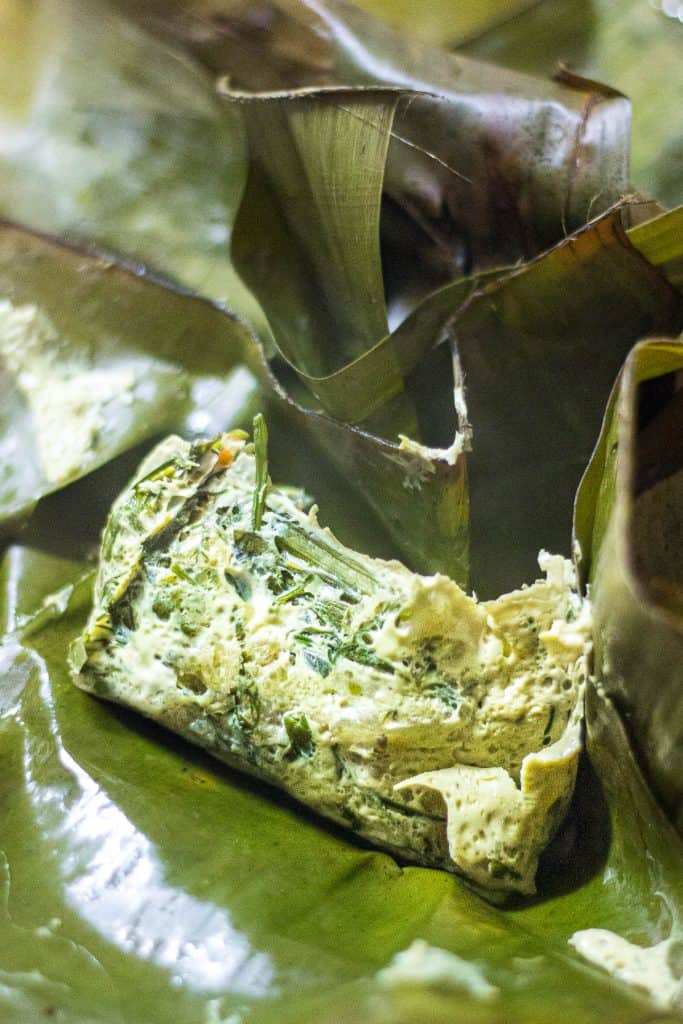
Why We Love This
These steamed fish parcels look and taste amazing! Pair them with rice and steamed greens for a satisfying and healthy meal.
Bathed in fresh, aromatic herbs, Lao Mok Pa is perfect for those who don’t like strong tasting fish. Lemongrass, chilli and spring onion add a burst of citrus alongside the herbaceous hit from fresh dill and kaffir lime leaf.
The addition of toasted sticky rice powder adds a unique texture and savoury nuttiness, helping to blend and bind the fish with all those incredible flavours. So good!
The recipe below is not overly spicy, while being super easy to adapt to your taste. Read on for ideas on how to make it your own.
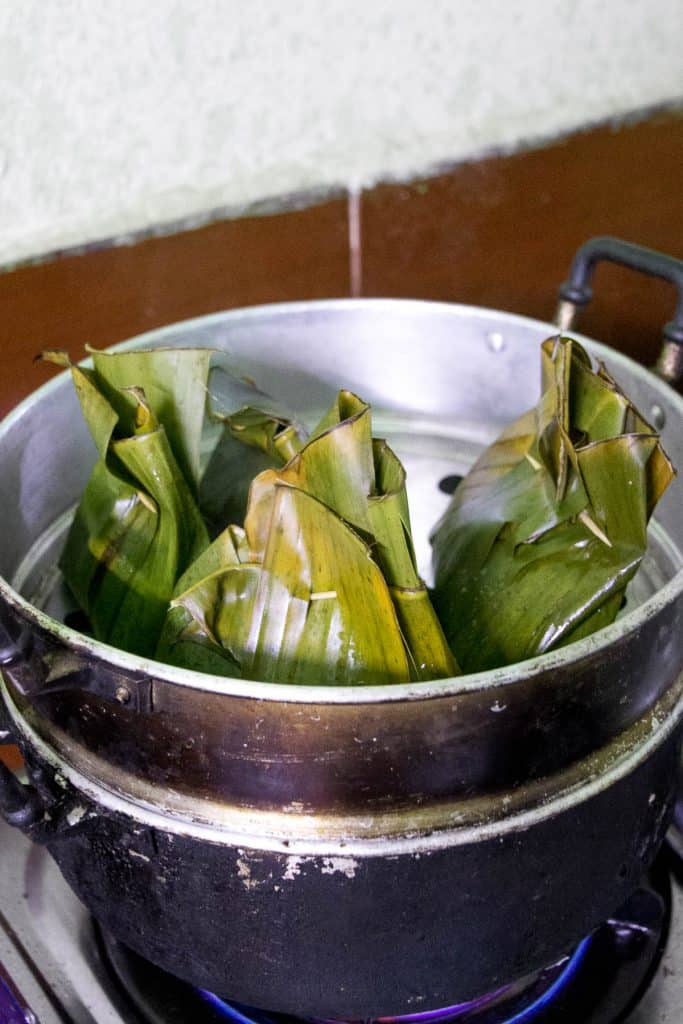
What is Steamed Fish in Banana Leaves (Mok Pa)?
Mok Pa is a popular steamed fish parcel from Laos made from white fish, herbs and seasonings, along with whole sticky rice grains or toasted sticky rice powder. The mixture is portioned out and wrapped up in parcels made from fresh banana leaves, before being steam cooked to perfection.
While Chinese steamed fish recipes consist of a whole fish or fish fillet bathed in a fragrant sauce, Lao fish parcels are a little different. Here, the fish fillets are first diced, then mixed with the herbs and seasonings. There’s no soy sauce, sesame oil or rice wine used in this recipe.
The rich umami flavour in mok pa comes from a Lao style fermented fish paste known as padaek. It’s very strong smelling, providing a unique flavour to Lao cuisine (similar to the use of miso paste in Japanese cuisine). Thankfully once it’s cooked you can hardly taste the ‘fishiness’ at all.
As with most Lao recipes, this dish is usually served with cooked sticky rice known as khao niao.
In Laos, it’s common for mok pa to be cooked in one parcel made from a whole banana leaf. But we love to portion out into individual parcels using smaller squares of banana leaf, the way we first learned to make it.
Where We Learned This
We first learned to how to cook steamed fish in banana leaves from our new friend Vanpeng in Laos’ capital city of Vientiane. Within minutes of arriving at her home we were talking and laughing just like old friends catching up for a family meal.
Vanpeng showed us the proper way to eat like a true Lao by tearing off a little ball of sticky rice and using it to scoop up some of the steamed fish. Sticky rice is probably the most important food in Laos. Not only do they eat it with almost everything, but they use it as their ‘cutlery’ as well!
What You’ll Need
- Fresh Fish – Since Laos is a land-locked country, Mok Pa is traditionally made with fresh-water fish, such as tilapia, from the Mekong River. You can use any white-fleshed fish that’s easy for you to source, such as snapper, barramundi, basa, cod, fluke or flounder. Avoid oily fish like bluefish, mackerel or swordfish.
- Fresh Herbs – You’ll need lemongrass, kaffir lime leaves, garlic, galangal (or sub with ginger) shallots, chilli, dill and spring onion. If needed, use jarred or frozen lemongrass and kaffir lime leaves.
- Sticky Rice Powder – This is the ‘glue’ that holds the cooked fish together. Make your own sticky rice powder at home, or look for it in the dried spices section at your nearest Asian grocer, or buy sticky rice powder online. Substitute with a handful of whole, uncooked sticky rice (mixed well through the mixture) or cornstarch if necessary (this will help give you the right texture if not the added flavour).
- Fish Sauce – Traditionally, this recipe calls for Laos’ padaek fermented fish paste. Sub with regular fish sauce or anchovy paste if needed.
- Banana Leaves – Fresh banana leaves are a great, environmentally-friendly container to steam your fish in. They also give a unique aroma to the dish. Look for fresh or frozen leaves at Asian or Latin American markets, and always wash and pat dry the leaves before use. If you can’t find banana leaves, substitute with baking paper or aluminium foil.
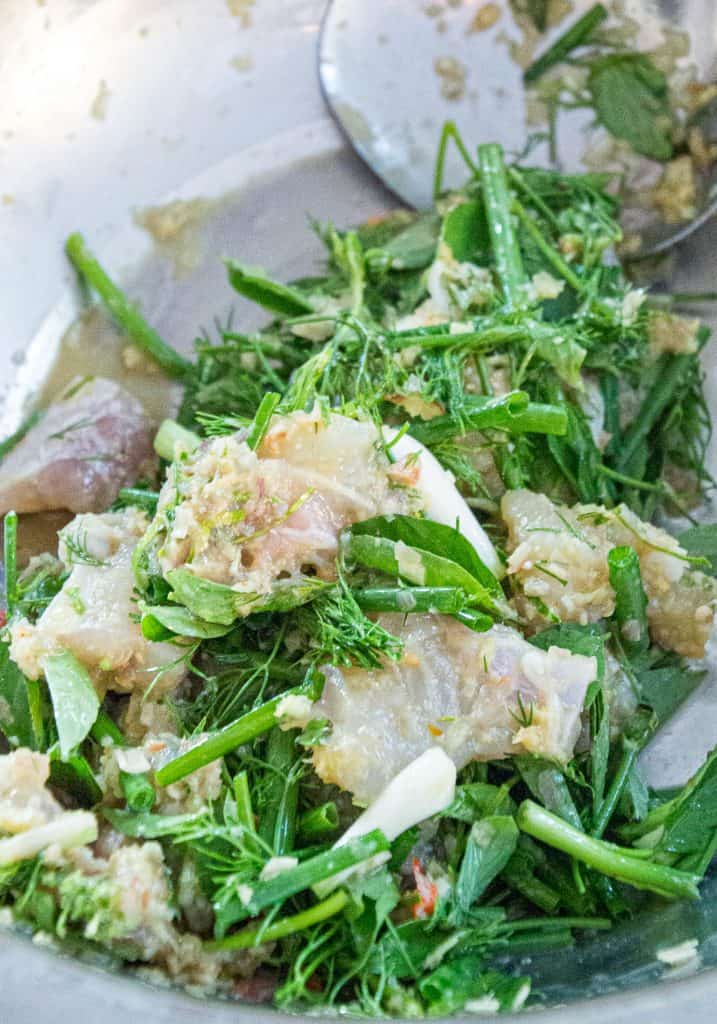
How to Wrap Fish in Banana Leaves:
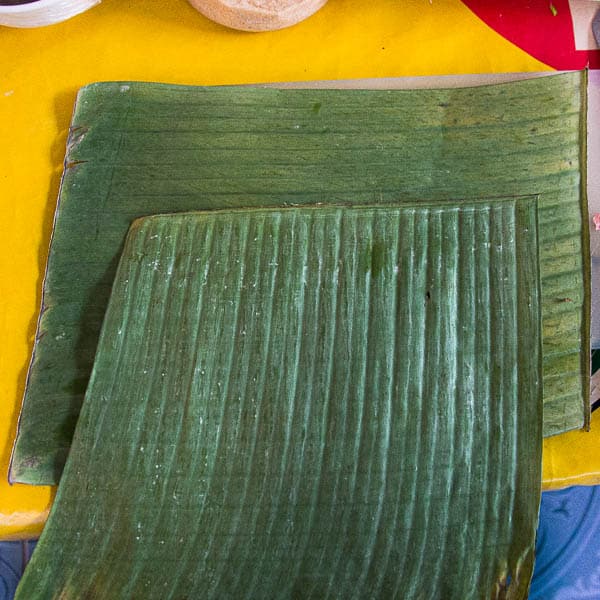
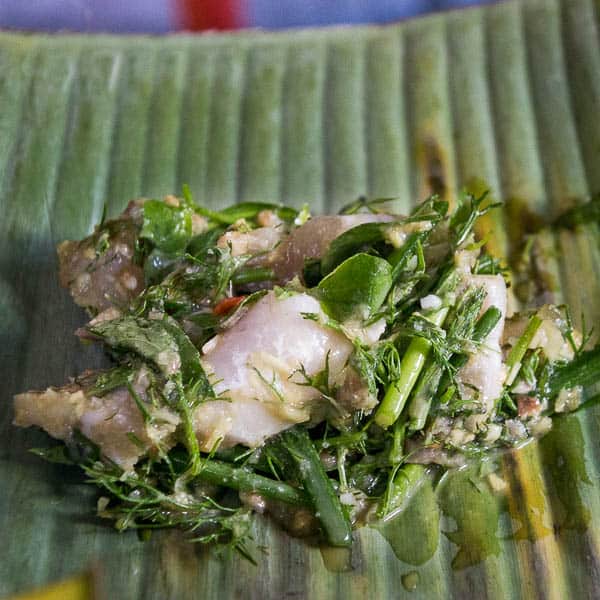
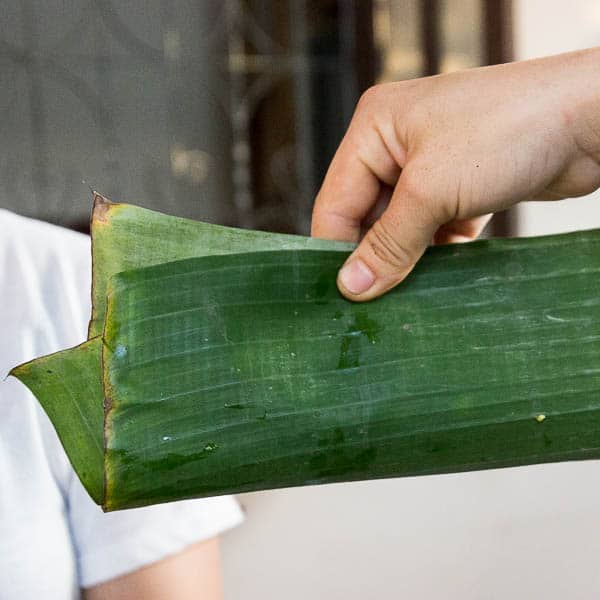
- Lay out two square pieces of banana leaf per fish parcel (outer leaf veins running horizontally, inner leaf veins running vertically on top).
- Place a ladle full of mixed fish and herbs in the centre.
- Fold the bottom edge of wrappers up to meet the top edge.
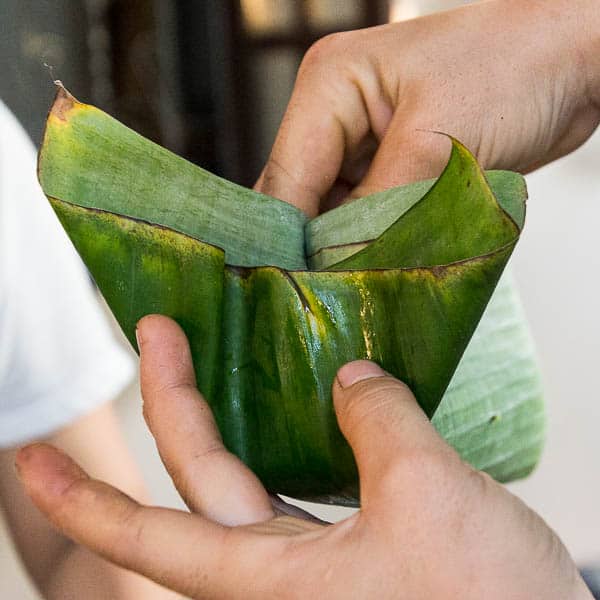
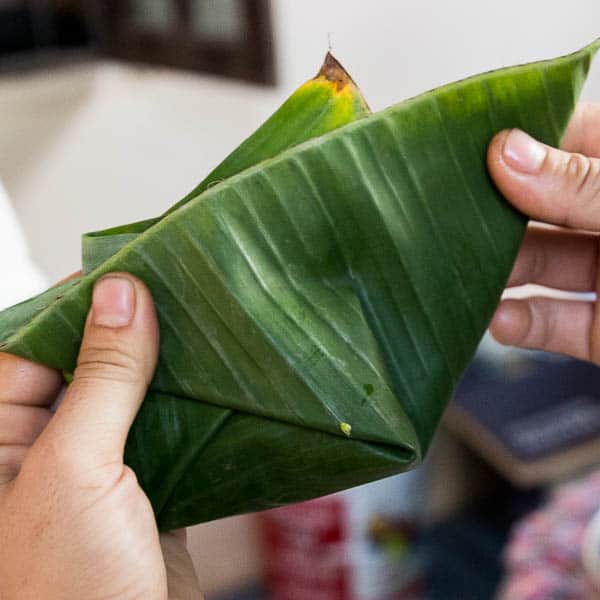
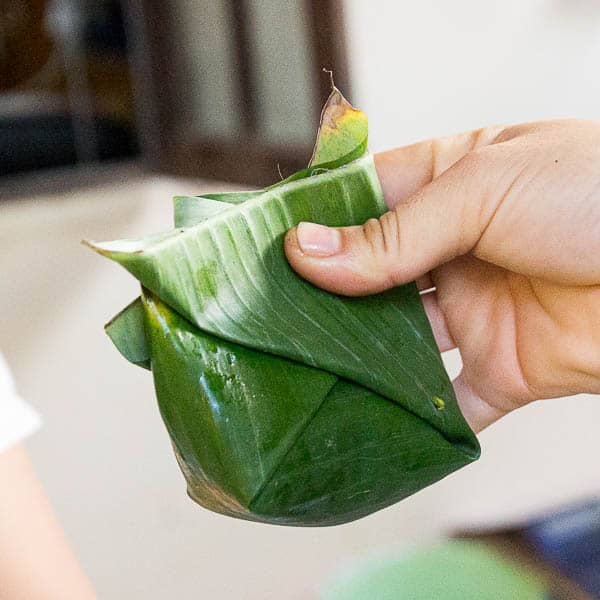
- Pinch the top and fold the left side in, then wrap the triangular shaped edges around the main parcel.
- Repeat for the right side.
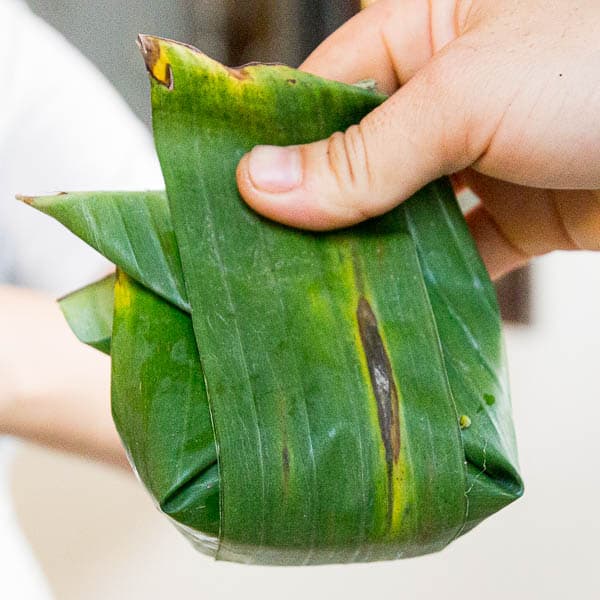
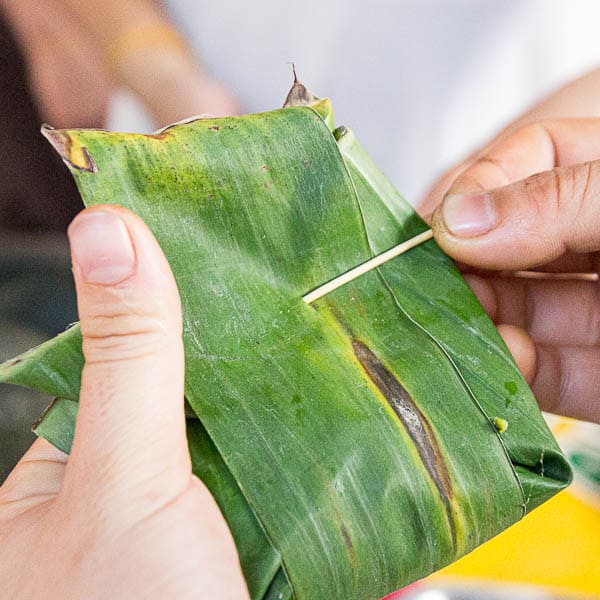
- (Optional) Wrap an extra strip of banana leaf (approx 30 x 4 cm / 11 x 1.5 inch) around the bottom of the wrapper to strengthen the parcel.
- Pin the tops together with a bamboo toothpick or skewer.
Wandercook’s Tips
- Fish – Make sure it’s properly filleted to avoid bones popping up in the final dish.
- Soften Fresh Banana Leaves – This makes them pliable and easy to fold. Hold each piece briefly over an open flame until it becomes a shiny bright green colour and releases the moisture in the leaves.
- If Using Frozen Banana Leaves – Layer them on a sheet of aluminium foil for a better seal, as they can easily their structure after being frozen and thawed.
- Layering the Leaves – Use two layers of banana leaf, with the outer layer placed ‘horizontally’ (according to the leaf grain) and the inner placed ‘vertically’. This not only looks good but helps to lock in all those delicious flavours.
- If You’re Feeling Lazy – Use a blender or food processor instead of a mortar and pestle to make the herb paste. Note: this will change the flavour due to ‘cutting’ instead of ‘bruising’ the aromatics. If you’re fine with that, then go for it!
- To Cook – Use a steamer, bamboo steamer, or a wok with a rack and lid.
- To Eat – Serve with sticky rice, and use a small ball of rice to scoop up a portion of fish to eat. Or simply serve on top of fluffy white rice with steamed broccoli or Asian greens.
FAQs
Yes! You can simply use a large pot or deep skillet with a lid, combined with a steaming rack or a small ceramic bowl (placed upside down) with a plate on top to hold the parcels. Pour around 5 cm / 2 inches of water in the bottom and you’ll be good to start steaming!
Fish cooks quickly compared with other meats, and since the fish is diced into small pieces, it will cook within 30 minutes. You can also watch for the colour change in the banana leaf wrapper. The bright green parcels will soften and change to a dark brown colour as they cook. Once that happens, they’ll be perfectly cooked and ready to eat.
Around 30cm (12 inch) squares will be perfect for this recipe. Remember to use two sheets per parcel, and layer one ‘horizontally’ and the other ‘vertically’ for the best seal.
Variations
- Make Stuffed Capsicum / Bell Peppers – If you can’t (or don’t want to) source banana leaves, stuff the mixture into capsicums / bell peppers instead. Easy, tasty, and just as environmentally friendly!
- Swap the Proteins – Try it with finely chopped chicken, pork or tofu.
- Adjust the Spice Level – Keep the chilli seeds in for a spicier experience, or scrape them out to temper the heat.
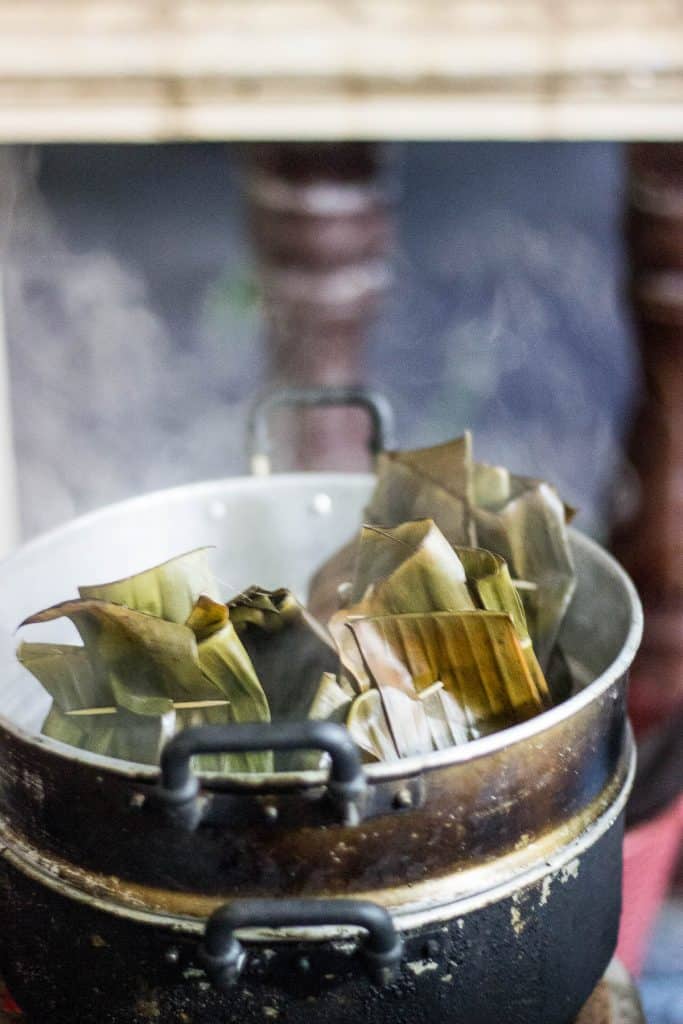
For more Southeast Asian flavours, try these amazing recipes next:
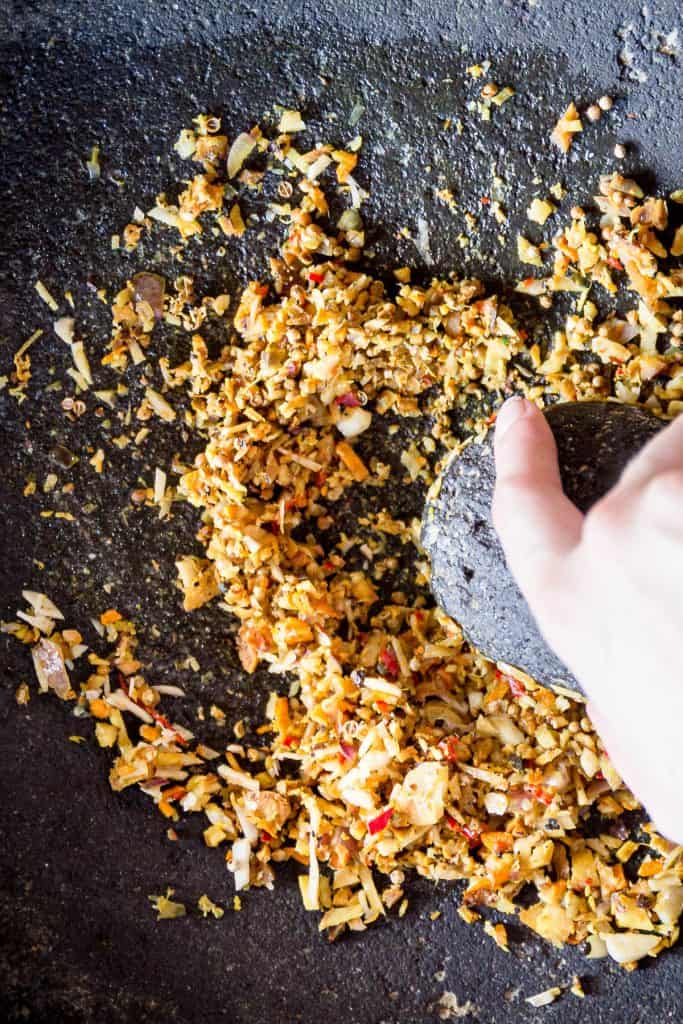
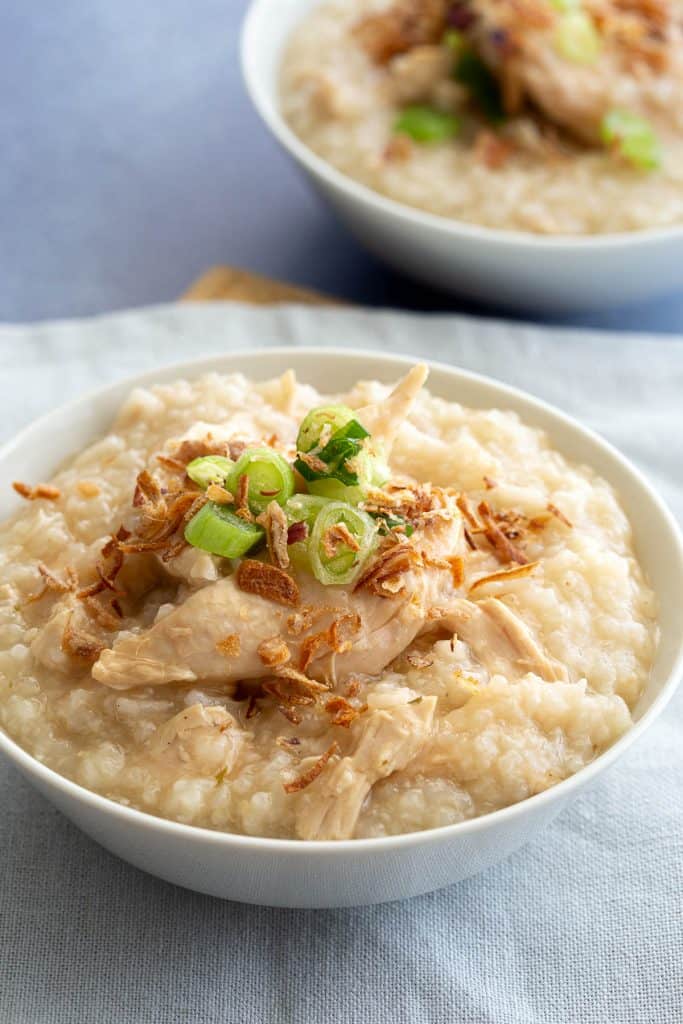
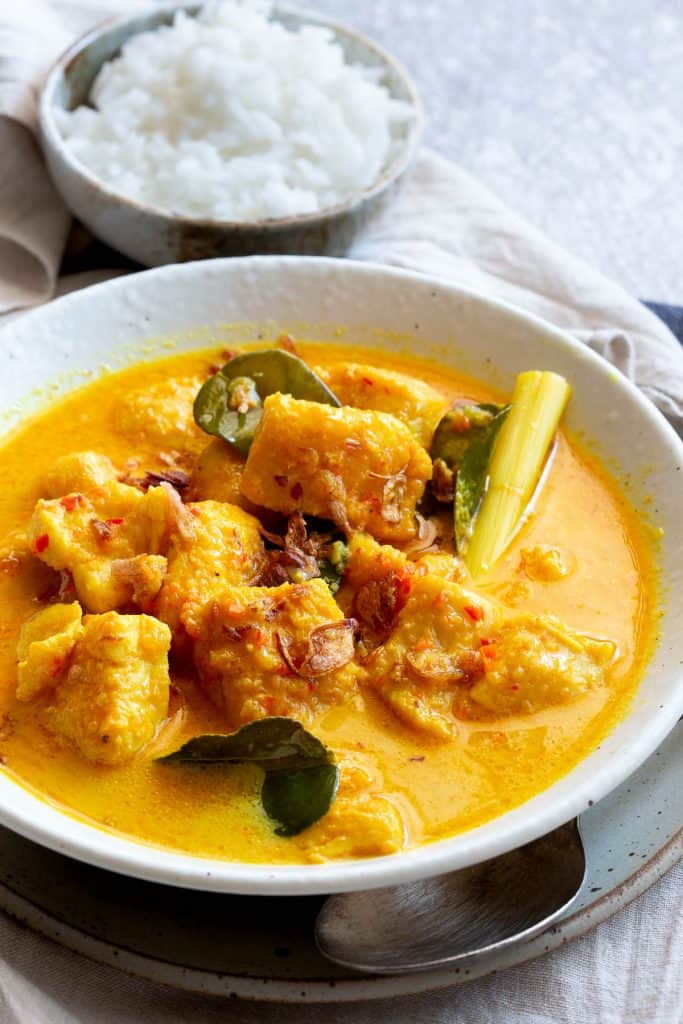
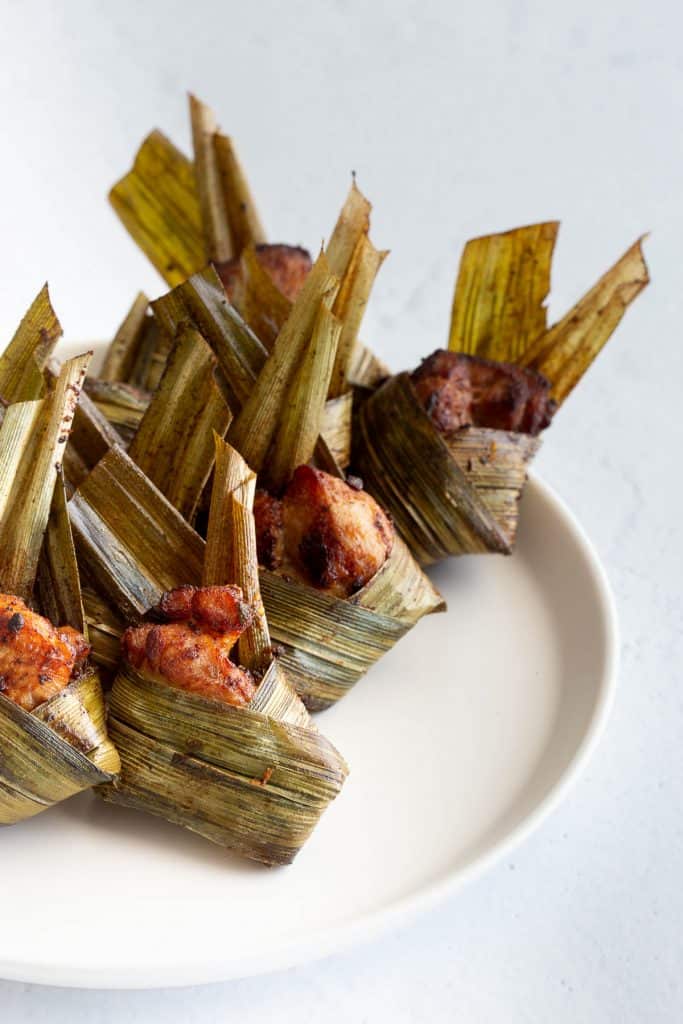
★ Did you make this recipe? Please leave a comment and a star rating below!
Ingredients
- 200 g white fish diced
- 5 cm lemongrass (2 inch) sliced and chopped small
- 2 Thai makrut / kaffir lime leaves finely sliced
- 2-3 cloves garlic chopped
- 2 shallots chopped
- 1 cm galangal (0.4 inch) chopped, fresh, or sub with ginger
- 1 chilli birds eye
- 1 tsp sticky rice powder or glutinous rice flour
- 1 tbsp padaek (Lao fish sauce) sub with normal fish sauce or anchovy paste
- 1 egg
- 1/2 cup dill chopped, fresh
- 1-2 spring onion / green onion chopped
- handful Thai basil leaves
- 8 sheets banana leaf or baking paper Optional: Additional 4 banana leaf strips (approx 30 x 4 cm / 11 x 1.5 inch) to reinforce the parcels
Instructions
For the fish filling:
- Place the chopped lemongrass, kaffir lime leaves, garlic, shallots, galangal, and chilli in a mortar and pestle and grind into a smooth paste.5 cm lemongrass, 2 Thai makrut / kaffir lime leaves, 2-3 cloves garlic, 2 shallots, 1 chilli, 1 cm galangal
- Meanwhile, place fish into a mixing bowl. Add the herb paste, sticky rice powder, padaek or fish sauce and egg. Mix well.200 g white fish, 1 tsp sticky rice powder, 1 tbsp padaek (Lao fish sauce), 1 egg
- Add the dill, spring onion and basil. Continue to mix until well combined.1/2 cup dill, 1-2 spring onion / green onion, handful Thai basil leaves
To fold the banana leaf parcels:
- Lay out two square pieces of banana leaf per fish parcel (outer leaf veins running horizontally, inner leaf veins running vertically on top).8 sheets banana leaf or baking paper
- Place a ladle full of mixed fish and herbs in the centre.
- Fold the bottom edge of wrappers up to meet the top edge.
- Pinch the top and fold the left side in, then wrap the triangular shaped edges around the main parcel. Repeat for the right side.
- (Optional) Wrap an extra strip of banana leaf (approx 30 x 4 cm / 11 x 1.5 inch) around the bottom of the wrapper to strengthen the parcel.
- Pin the tops together with a bamboo toothpick or skewer.
To cook:
- Place parcels into a steamer. Cover and steam for 30 mins.
- Serve with sticky rice.
Recipe Notes
- Fresh Fish – Since Laos is a land-locked country, Mok Pa is traditionally made with fresh-water fish, such as tilapia, from the Mekong River. You can use any white-fleshed fish that’s easy for you to source, such as snapper, barramundi, basa, cod, fluke or flounder. Avoid oily fish like bluefish, mackerel or swordfish. Tip: Make sure it’s properly filleted to avoid bones popping up in the final dish.
- Fresh Herbs – You’ll need lemongrass, kaffir lime leaves, garlic, galangal (or sub with ginger) shallots, chilli, dill and spring onion. If needed, use jarred or frozen lemongrass and kaffir lime leaves.
- Sticky Rice Powder – This is the ‘glue’ that holds the cooked fish together. Make your own sticky rice powder at home, or look for it in the dried spices section at your nearest Asian grocer, or buy sticky rice powder online. Substitute with a handful of whole, uncooked sticky rice (mixed well through the mixture) or cornstarch if necessary (this will help give you the right texture if not the added flavour).
- Fish Sauce – Traditionally, this recipe calls for Laos’ padaek fermented fish paste. Sub with regular fish sauce or anchovy paste if needed.
- Banana Leaves – Fresh banana leaves are a great, environmentally-friendly container to steam your fish in. They also give a unique aroma to the dish. Look for fresh or frozen leaves at Asian or Latin American markets, and always wash and pat dry the leaves before use. If you can’t find banana leaves, substitute with baking paper or aluminium foil.
- Soften Fresh Banana Leaves – This makes them pliable and easy to fold. Hold each piece briefly over an open flame until it becomes a shiny bright green colour and releases the moisture in the leaves.
- If Using Frozen Banana Leaves – Layer them on a sheet of aluminium foil for a better seal, as they can easily their structure after being frozen and thawed.
- Layering the Leaves – Use two layers of banana leaf, with the outer layer placed ‘horizontally’ (according to the leaf grain) and the inner placed ‘vertically’. This not only looks good but helps to lock in all those delicious flavours.
- If You’re Feeling Lazy – Use a blender or food processor instead of a mortar and pestle to make the herb paste. Note: this will change the flavour due to ‘cutting’ instead of ‘bruising’ the aromatics. If you’re fine with that, then go for it!
- To Cook – Use a steamer, bamboo steamer, or a wok with a rack and lid.
- To Eat – Serve with sticky rice, and use a small ball of rice to scoop up a portion of fish to eat. Or simply serve on top of fluffy white rice with steamed broccoli or Asian greens.
- Make Stuffed Capsicum / Bell Peppers – If you can’t (or don’t want to) source banana leaves, stuff the mixture into capsicums / bell peppers instead. Easy, tasty, and just as environmentally friendly!
- Swap the Proteins – Try it with finely chopped chicken, pork or tofu.
- Adjust the Spice Level – Keep the chilli seeds in for a spicier experience, or scrape them out to temper the heat.
Nutrition
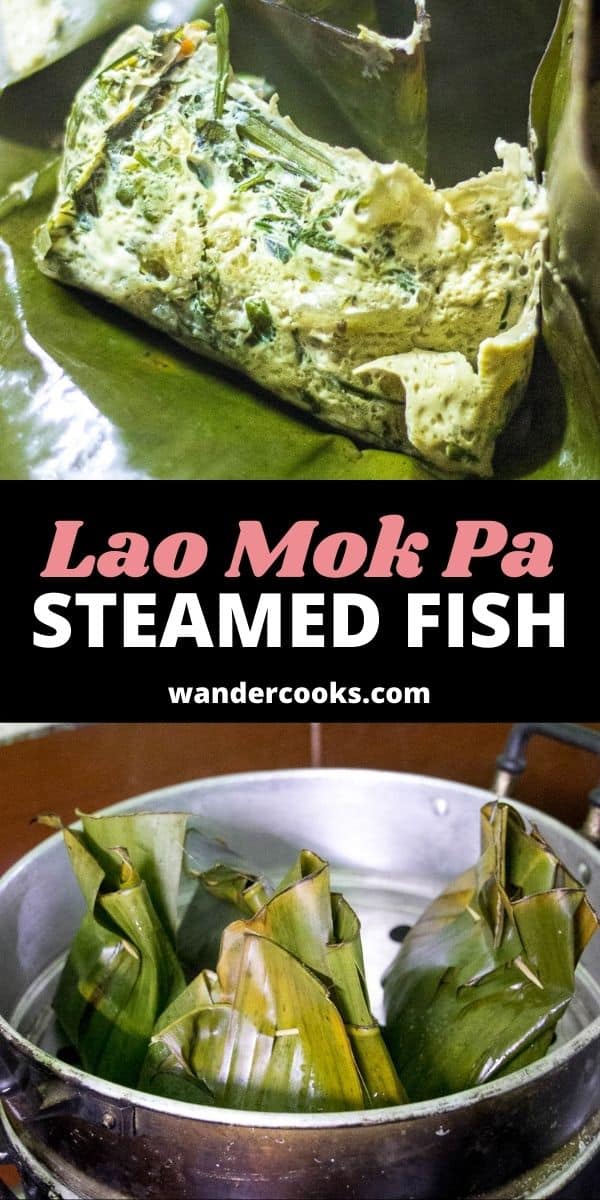

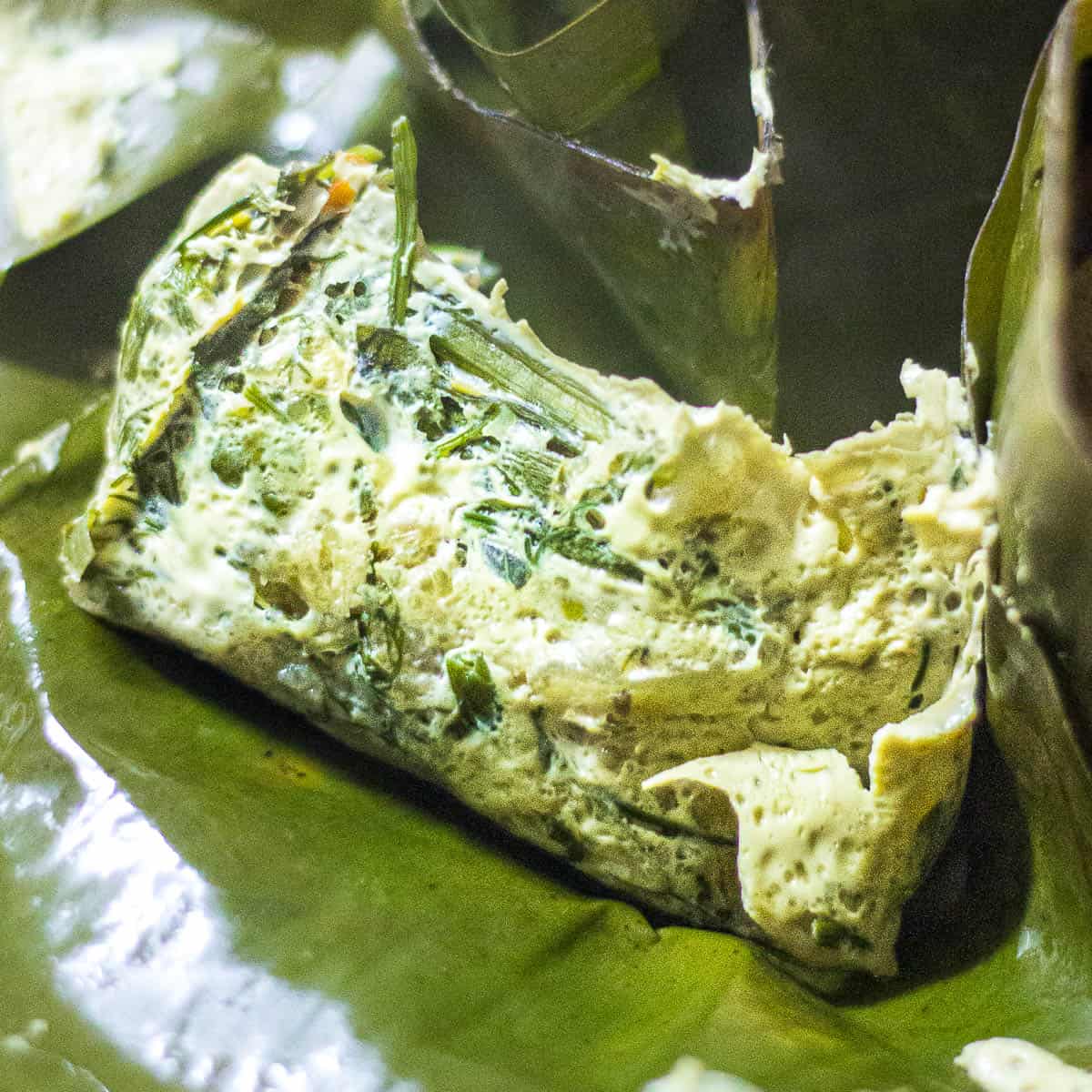

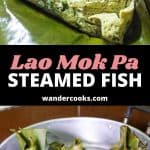
16 Comments
krish recipes
21/04/2016 at 2:20 amLoved the banana leaf wraps. Looks great and delicious
Wandercooks
21/04/2016 at 12:51 pmThanks Krish, they make it just that extra bit of special don’t they?
Heather
19/04/2016 at 12:10 pmLove this recipe! This is a dish I don’t get to treat myself to often but now I can make it at home!! Excellent wrapping tutorial too 🙂 Thanks for sharing!
Wandercooks
19/04/2016 at 12:45 pmGlad to help Heather! Pictures definitely say 1000 words when it comes to wrapping up instructions hehe. Hope you get to treat yourself soon!
Trish
19/04/2016 at 11:51 amOoooh this sounds so light and delicious! Nicely done!
Wandercooks
19/04/2016 at 12:44 pmThanks Trish, you’re spot on there. The fish was so light and delicious, full of flavour and impossible to stop eating with sticky rice. 😀
Gloria @ Homemade & Yummy
18/04/2016 at 10:09 pmWhat an interesting way to prepare fish. Too bad I don’t have access to those leaves here. Nicely done.
Wandercooks
19/04/2016 at 12:40 pmThanks Gloria. Fingers crossed you can find them somewhere. We’ve managed to source some in the freezer section at our Asian grocery!
Dannii @ Hungry Healthy Happy
18/04/2016 at 8:18 pmWe had something very similar when we were in Thailand and it was amazing. I can almost smell it now!
Wandercooks
18/04/2016 at 8:25 pmYes! The Thai one is very popular, we had no idea Laos had a version as well. Did you make it as well or just eat the deliciousness? Haha
Padaek
16/12/2015 at 12:53 pmA wonderful and classic Lao recipe. It looks absolutely saap! Thank you for sharing. I’ve shared the post on my Facebook page. Merry Christmas and safe travels. 🙂
Wandercooks
16/12/2015 at 7:18 pmHey thanks so much, glad you like it. This one was definitely one of our favourites from Laos. Merry Christmas to you too, hope you enjoy this wonderful time of year 🙂
Martin @ The Why Chef
10/12/2015 at 7:11 pmThis looks great, and healthy! Just need to find somewhere in the UK selling the banana leaves and glutinous rice flour (probably ebay!) Cheers!
Wandercooks
10/12/2015 at 7:52 pmGlad you like the recipe Martin! If you have any Asian supermarkets nearby give them a try – the banana leaves can often be found in the freezer section. You can also use baking paper as an alternative. 🙂
Martin @ The Why Chef
10/12/2015 at 8:58 pmAh didn’t even realise they could be frozen! I’ll give that a look later today! The banana leaves really add to the theatre of it, so I’m keen to get these. Thanks again!
Wandercooks
10/12/2015 at 9:37 pmTotally agree, they look amazing! We found the banana leaves in the freezer section when we went looking for pandan leaves one day haha. Have fun! 🙂